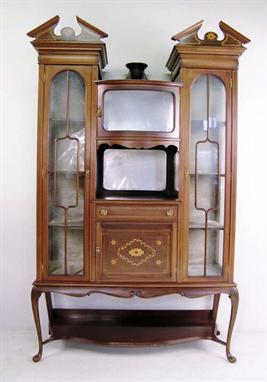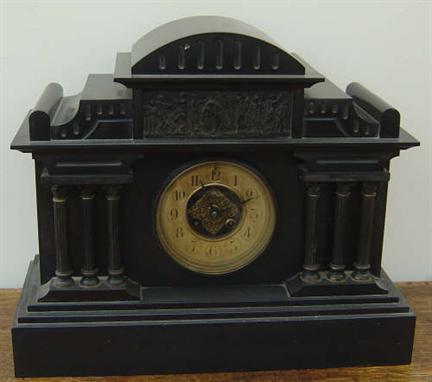We found 35023 price guide item(s) matching your search
There are 35023 lots that match your search criteria. Subscribe now to get instant access to the full price guide service.
Click here to subscribe- List
- Grid
-
35023 item(s)/page
A late 19th century French faience mantel clock, the 11cm silvered dial embossed with acanthus leaves and applied with enamelled cabochon Roman numerals, twin-winding holes, eight-day movement, the case with architectural pediment, acanthus capped pilasters, shaped rectangular base, bracket feet, decorated in puce with cherubs medallion swags and scrolls, on a cream and pink ground, 39cm high, c.1880
A Victorian skeleton clock of architectural form, the pierced silvered chapter ring of roman numerals, single fusee movement striking on a single bell, the pierced back stamped '13’ on four short turned feet and oval veined white marble base with three white glazed compressed bun feet under a glass dome, 16.5" high
An Edwardian mahogany chequer strung display cabinet, the break top with central pediment bracket flanked by two raised architectural pediments, the centre bowfront glazed cabinet above a mirror back open well, short drawer and single roundel inlaid cabinet flanked by full length arched cabinet doors revealing three fixed shelves with full length and glazed panel, the C scroll moulded apron over a serpentine shelf stretcher uniting the front corner cabriole legs, terminating in a pad foot and shaped back support, 47.5" wide, 75" high, 16" deep
A German walnut rectangular wall clock circa 1900 in the Vienna regulator style the eight-day two-train movement with deadbeat anchor escapement the white enamelled round dial subsidiary seconds dial and chapter ring with Roman numerals in a typical architectural case with shaped pediment applied with a female mask 117cm high
An Edwardian oak cased bracket clock the eight-day three-train movement with anchor escapement and striking the hour on a coiled gong and chiming the quarters on eight graduated bells the brass dial with silvered chapter ring with Roman numerals and Arabic five minute divisions beneath three subsidiary dials for 'slow/fast’ 'chime/silent’ and 'Chime on eight bells/Westminster chimes’ in an architectural Corinthian order portico case with rusticated lower section 59cm high; and a wall bracket
A mid 19th century Chinese lacquer desk/work table painted overall with Oriental figures and buildings in landscapes in gilt and red on a black ground the stylised flower crest on an architectural pediment above two doors enclosing a pocket watch holder and other fittings the base with a detachable work box with double hinged top and two drawers on cabriole legs with hairy paw feet 157cm high 64cm deep 63.5cm wide (some wear to gilt paintwork See Crossman Carl L; The Decorative Arts of The China Trade plate 150 for a similar example
*British School late 19th century- 'Consett Waterworks, Hislehope Reservoir Details of Tunnel Outlet'; pen and coloured ink and watercolour, original architectural elevations and plans, dated July 1896, 64.7x98cm: together with eight other similar architectural studies and one further smaller example, including those depicting: 'Weardale Water Works, (6), Tunstall Reservoir,(1), Barnslet Water Works, (1), Lowestoft Water Works, (1), and SouthPort Water Works, (1), (11), (unframed)
Henry W Binns, Architect 141 Park Road, NW, (Binns and Scarlett, Architects, 19 Southampton Place, London, WC1)- House in Regency Close, St John's Wood, NW; gouache, signed 'Gick' and dated 39, inscribed on mount, 39x61cm: together with four other architectural designs in gouache and pen and ink from the same architect's practice, (5). Note: The first item was exhibited in The Royal Academy in 1940, No. 1415. A letter of provenance accompanies this lot
Jerimius Wolff, 1663-1724- 'Gratz'; engraving, 32.5x108.5cm: G. E Rosenberg- 'Vue Perspective de l'Eglise Royale de Frederic V qui s'execute a Copenhague 1763'; engraving, 1763, 26x38.8cm: together with a mixed folio of prints of architectural subjects, including a complete booklet with wraps by Anton Ortner, (a lot), (unframed)
A mahogany and inlaid Stick Barometer. Berringer, London. With silvered plate signed as above and engraved with foliage and flower heads and with mercury thermometer, the case with architectural pediment, parquetry stringing, and turned cistern cover, marquetry inlaid with a flower head. 37.5in high
A Victorian Garnet Carbuncle and Enamel Demi Parvre, of architectural design, the chain necklace supporting three pendant drops each with an oval shaped plaque with a cabochon garnet centre within a beaded and white enamel frame and further drops, with matching bangle and brooch, in fitted Victorian case.
A COLLECTION OF ENGRAVINGS AND REPRODUCTIONS including examples by or after Wm. Green, Andrew Picken, J.S. Cotman, T. Girtin, J. Gibson, C.G. Fossat, Domenichino, W. Grimelin, J. Gould, G. Cuitt, D. de Rossi and others, including: architectural, landscape and religious subjects, varying sizes, unframed 14 x 20in and smaller; and six volumes of The Florist's Journal (1840-1845 ) sold a/f.
*SIMON JONES (Contemporary) india Buildings, Liverpool, signed and dated 'Simon Jones, 86' and further inscribed as title (lower left) watercolour 26 x 29 ½in (66 x 75cm) India Buildings in Water Street, Liverpool was built for Alfred Holt and Co. as a headquarters for the Blue Funnel Line. It was designed by Arnold Thornely and Herbert J. Rowse who had won the competition for this building in 1923 (assessor Giles Gilbert Scott). It was built between 1924-30. Extensively damaged by bombing in 1941, it was reconstructed under Rowse's supervision. Steel-framed, with cliff-like Portland stone walls, and Italian Renaissance detail, its original building cost was #1,250,000. Rowse, the architect had travelled extensively in America. The building in scale, combination of functions and architectural treatment emulates the most ambitious of early 20th Century American commercial buildings. Sold with this lot are nine watercolours (mounted in three frames) by William L. Stevenson depicting Bird and Botanical subjects: these include 'Pigeon Orchid, Hibiscus Oleander, Mandarin's Duck, and Lady Amherst's Pheasant'.
A mid 19th century Continental satinwood sécrètaire à abbattant in the Biedermier taste, the stepped pediment with architectural frontage over a slim drawer and fall enclosing a mahogany veneered interior with single long drawer above a cupboard door and stepped drawer, flanked by two smaller cupboard doors over two drawers all over three long drawers, on bowed bracket feet, 99 cm wide x 167 cm high
A Regency giltwood and gesso mantel mirror in the manner of Robert Adam, the architectural pediment with flaming torch and quiver of arrows central motif within an egg and dart decorated cornice, above a break-front frieze decorated with lion mask, scrolling foliate sprays and linen swags, the central circular plate with bevelled edge within a ribbon decorated foliate border and outer floral medallions, flanked by two rectangular plates, each with reeded ebonised slips interspersed by fluted and acanthus capped reeded columns, on a beadwork decorated base, 144.5 cm wide x 92.5 cm high
A late 19th Century slate mantel clock with eight day movement striking on a bell, the gilt dial with white enamel chapter ring and Arabic numerals, the architectural case decorated in relief with a classical scene, on a rectangular base, together with an aneroid barometer within a wooden ropetwist frame.
An early20th Century green onyx and gilt metal clock garniture, the clock with eight day movement striking on a gong, the gilt dial and white enamel chapter ring with Arabic numerals, the architectural case with four fluted columns above a rectangular plinth base, together with a pair of matching ornaments, each in the form of statues within a gazebo.
A Regency mahogany and brass mounted bracket clock with twin fusee movement striking on a bell, the circular enamel dial with Roman numerals and inscribed 'Newsom, Tottenham', the case with architectural top above pierced brass panels and ring handles on a rectangular base and bun feet, height approx 47.5cm.
A fine early 19th century Biedermeier secretaire, veneered in figured walnut, the stepped and moulded top above a penwork decorated drawer depicting a classical frieze of Zeus and Cupid with serpents and scrolling arabesques, the arcaded fitted interior mirror backed and decorated penwork, the fitted drawers inlaid stringing, some to simulate brickwork, to the burr ash veneer, brass capped columns enclosed by a fall-flap banded in berried foliage penwork on sycamore, above three long oak lined drawers, fitted chased gilt bronze escutcheons, flanked by brass capped pillars on half bun feet. 3ft. 5in. (1.04m.) x 5ft. 2in. (1.57m.). North German. A design that can be linked to the formal empire Biedermeier work of Karl Friedrich Schinkel, an important architect and designer from Berlin who used architectural features in his furniture designs.
J. P. Davies, Minding the Flock, watercolour, 12 x 17cm; after J. Marchant, The South end of St. James's Palace, hand coloured engraving, 22.5 x 40.5cm; after C. Lorain Smith, 'Pychely Hunt' and 'Push him up Tomboy', a pair of hand coloured prints, published 1790 by F. Jukes; and an architectural print of Dartington House, Devonshire (5).
-
35023 item(s)/page

































